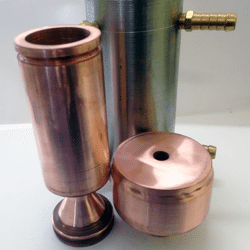One of the advantages of additive manufacturing is the ability to create detailed and complex components that cannot be manufactured by conventional means. When the 3D printing of complex components made of precious metal alloys are advantageously starting to use miniature lattice structure (i.e. Lattice structure) that is used to fill the volume of the body. The use of nanotechnology comes handy here. Material consumption for example, titanium powder is minimal while ensuring overall strength, flexibility and rigidity of the structure. Other advantages of such structures are the absorption of impact energy, vibration and noise insulation and, thanks to their low density, also serve as a thermal insulator. Let’s look at some interesting case studies where additive manufacturing innovation has played a key role.

Professionals summarize in a paper the advantages and functions of miniature trusses. In addition to the advantages themselves, the article will show you how to construct truss structures correctly, what to choose powder metal, what are hybrid truss structures and other interesting information. The future of lattice structures produced by 3D printing and their use is also demonstrated by case studies:
3D printing turbocharger
Complex lattice structures can provide exceptional performance in terms of both efficiency and functionality. They are a key tool in lightweight construction and can help accelerate heat transfer, energy absorption and insulation. Currently, additive manufacturing is the only way to make these structures. The latest software tools and professional 3D printers are optimized to work with fine detail to design the lattice structure. Turbocharger filled with lattice construction made of aluminum for Formula Student.
Metal foam construction
3D printing of metal foam is faster and cheaper than conventional. This consists of using powder metal in combination with a blowing agent, which is generally titanium hydride TiH 4. This mixture yields an intermediate in the form of a wire, which is hot foaming in a batch process. This process is lengthy and costly, so it is preferable to use additive technology.
Structural optimization of architectural spider
This component combines topological optimization with a truss structure to minimize component weight. The original design was based on individual arms that connect architectural glass panels used, for example, in atriums or all-glass buildings. Organic design with its complex elements was created in Altair’s OptiStruct software, while Materialize Magic was used to enhance and complete the design. The internal structure is designed to also support the 3D printing process. There is no need to create additional production support.
Machining
If the part is clamped and the clamping is rigid enough, finishing operations can begin. The resulting machining accuracy is related to the accuracy and rigidity of the machine, tool, and workpiece and jig system, CNC machine tool accuracy. Production accuracy is verified by 3D measurement or scanning. The resulting component has the correct dimensions, which are within tolerance and have a good surface. Tool wear is much lower than in early machining.
Precision machining is often a very important element in the additive manufacturing process. Functionally optimized components of additive manufacturing need not be too rigid and often require complex preparations. 3D printed sleeves (jaws) can provide a good solution in this case.
Clamping
If you cannot simply change the design of a part without losing the benefits of additive technology, we have to look at other ways of clamping. You need to find a way to create support between the two flange ends to minimize vibration and deflection. In addition, the component must not be damaged by firm gripping.

